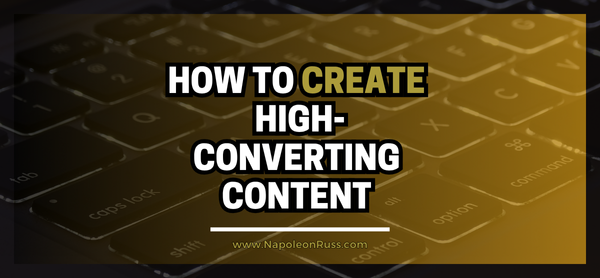(A Beginner’s Journey to Building Trust, Connection, and Conversions)
When I first started affiliate marketing, I honestly had no idea what I was doing. I spent hours watching videos, creating posts, and trying to copy what successful marketers were doing — but the results didn’t match the effort.
It wasn’t that I wasn’t trying hard enough. It was that I was trying the wrong things. I focused on content quantity instead of content connection. I pushed products before I built relationships. And I learned the hard way that great content doesn’t convert unless it connects emotionally first.
Over time — through trial, error, and a lot of reflection — I began to understand what separates random content from high-converting content. This post breaks down what I’ve learned so far about creating affiliate marketing content that actually converts, even if you’re just starting out like me.
Step 1: Understanding Your Audience’s Pain Points and Dream Outcomes
If there’s one concept that completely changed how I create content, it’s this:
“Stop focusing on the sale and start focusing on the story your audience is living.”
When I used to make content, I thought about what I wanted to promote. Now I think about what my audience is struggling with.
Identify Pain Points
Every piece of high-converting content starts with empathy. To connect with people, you have to understand what keeps them stuck. For me, that meant spending time reading Facebook group comments, watching YouTube videos, and even talking to friends who were trying to make money online.
I started noticing common struggles:
- Feeling overwhelmed by too much information
- Struggling to get consistent traffic
- Doubting their ability to actually make money online
- Worrying about wasting time and money on the wrong systems
When I began creating content around these struggles — rather than just promoting products — people started responding differently. They’d comment, message, or even share my videos. That’s when I realized empathy is the foundation of conversion.
Define Dream Outcomes
Once I understood their pain points, I needed to define their dream outcomes — what success actually looks like for them.
For most people, it’s not just “making money online.” It’s:
- Having the freedom to spend time with family
- Leaving a stressful job
- Feeling confident in their business skills
- Building something meaningful that lasts
When I frame my content around those goals — helping people get from their current pain (Point A) to their dream outcome (Point B) — my message feels more purposeful and less “salesy.”
Bridge the Gap
The heart of your content should be the bridge between those two points. That’s where you provide value.
Now, every time I create a video or post, I ask:
- Does this help my audience take one step closer to their dream?
- Does it make them feel understood and supported?
When you focus on helping people cross that bridge, conversions happen naturally — because people trust you.
Step 2: Build Trust Before Trying to Sell
I learned early on that trust is everything in affiliate marketing. People can sense if you’re just trying to make a sale. But when they feel like you genuinely care about helping them, they’ll start listening, following, and eventually buying.
Focus on Helping, Not Selling
At first, I used to end every video with a link to an offer. Now, I focus on creating educational content that solves a small part of my audience’s problem — even if it doesn’t lead directly to a sale.
For example, instead of saying, “Here’s this amazing affiliate program,” I’ll say, “Here’s what I learned about writing content that converts — and here’s a tool that helped me do it better.”
That shift from selling to serving completely changes how people perceive you.
Create Educational Content
Educational content is one of the best ways to build trust and authority — even as a beginner.
When you teach something you’ve just learned yourself, you’re not positioning yourself as a guru — you’re positioning yourself as a fellow learner who’s one step ahead. That relatability builds stronger connections than perfection ever could.
Some of the educational content ideas I use include:
- “What I learned after my first 30 days in affiliate marketing”
- “3 mistakes I made when starting my YouTube channel”
- “How I create content that actually gets clicks”
These types of posts don’t just teach — they connect.
Engage and Interact
Building trust isn’t just about what you post — it’s about how you respond.
Platforms like TikTok, Instagram, and YouTube Shorts are great for discovery, but I’ve learned that deeper connections happen in private spaces like Facebook groups or DMs.
When someone comments on your content, reply. When someone asks a question, answer it personally. When someone shares a struggle, show empathy.
Those conversations build real trust — and trust leads to conversions.
Step 3: Be Transparent and Authentic
If there’s one thing people crave online, it’s authenticity.
When I started sharing my real journey — the ups, the downs, the wins, and the struggles — I noticed people resonated more deeply. They didn’t want another highlight reel. They wanted to follow someone who was genuinely learning and growing.
Share Your Journey Honestly
You don’t have to pretend to be an expert. Instead, share what you’re learning as you go. Talk about the mistakes you’ve made, the lessons you’ve learned, and what’s working for you right now.
People don’t follow perfection — they follow progress.
Show Vulnerability
It’s okay to admit when something doesn’t go as planned. For example, I once spent days creating a video that barely got any views. Instead of hiding it, I shared what I learned about YouTube SEO from that experience. That post ended up being one of my most engaging ones.
When you’re vulnerable, you humanize your brand — and that’s how you build deeper trust.
Demonstrate Consistent Integrity
If you recommend a product, be honest about what you like and what could be better. Transparency like that builds long-term credibility.
When people know you’re honest — even when it’s not convenient — they’ll listen to your future recommendations.

Step 4: Use Storytelling to Make Your Content More Engaging
Storytelling has become one of my favorite ways to connect with people. It’s not just about selling a product — it’s about sharing experiences that your audience can relate to.
Here’s how I structure my stories now:
1. Share a Personal Struggle
Start with something real — something you’ve personally faced. Maybe you were frustrated with trying to make your first commission, or you felt overwhelmed by social media algorithms.
That honesty captures attention because your audience sees themselves in your story.
2. Show the Turning Point
Then, share the “aha moment” — what changed? Maybe you learned a new strategy, found a helpful resource, or simply shifted your mindset.
3. Introduce the Solution Naturally
If a product or tool helped you, mention it naturally as part of your story, not as a sales pitch. For example:
“When I first started managing multiple affiliate links, I was completely disorganized — until I started using [tool name]. It helped me simplify everything.”
This approach integrates promotion into storytelling without breaking authenticity.
4. End with a Lesson
Every story should have a takeaway. What did you learn, and how can others apply it to their journey?
When people see themselves in your story — and learn something from it — they’ll trust you more and engage deeper.
Step 5: Structure Your Content for Clarity and Connection
Creating great content isn’t just about what you say — it’s how you say it.
One thing that helped me immensely was using a simple storytelling structure based on past, present, and future experiences — a concept aligned with the 4 Phases to Freedom Roadmap (Phase 2: Traffic & List Building) from Jonathan Montoya’s system.
Past Experiences
Talk about where you started.
- What problems were you facing?
- What mistakes did you make?
- What lessons did you learn?
Example:
“When I first started affiliate marketing, I thought success meant posting as much as possible. I quickly realized that quantity without strategy just leads to burnout.”
Present Experiences
Share what you’re currently doing to improve.
- What tools or systems are you using now?
- What’s working and what’s not?
Example:
“Right now, I’m focused on building my email list using a simple lead magnet. I’ve learned that building a list is more important than chasing viral videos.”
Future Experiences
Talk about your goals and vision.
- What do you want to achieve next?
- How do you plan to get there?
Example:
“My next goal is to automate my affiliate business so I can focus more on creating content that helps others. I’m still learning, but I’m committed to staying consistent.”
This structure makes your content easy to follow and helps your audience connect emotionally to your journey.
Step 6:
Stay Consistent and Track Progress
Consistency has been one of my biggest challenges — and lessons.
I used to create content in bursts of motivation, then disappear for weeks. Now I understand that consistency compounds. Even small, consistent actions lead to big results over time.
Create a Simple Schedule
You don’t need to post every day. Start with what’s manageable — like 3 videos a week or 2 blog posts a month. The key is consistency, not perfection.
Batch Your Content
I learned that batching content saves a ton of time. Spend one day scripting, one day recording, and one day editing. That way, you stay productive without burning out.
Track What Works
Use analytics to see what’s resonating. Which posts get more engagement? Which videos drive the most clicks? Use that data to refine your strategy.
Remember — what gets measured gets improved.
Step 7: Focus on Long-Term Relationships
Affiliate marketing isn’t about one-time commissions. It’s about long-term relationships — both with your audience and the brands you promote.
When you serve your audience first, your brand becomes trusted. And when people trust you, they’ll follow your recommendations — not because you’re selling, but because they believe in your journey.
My Key Takeaways (and What I’m Still Learning)
Creating high-converting content for affiliate marketing is not about being perfect — it’s about being real, helpful, and consistent.
Here are the biggest lessons I’ve learned so far:
- Start with empathy. Understand your audience’s struggles and dreams.
- Focus on connection, not conversion. Sales will follow trust.
- Use stories, not scripts. Share your real experiences.
- Be transparent and authentic. People connect with honesty.
- Stay consistent. Even small, steady progress compounds.
I’m still learning every day — testing new strategies, refining my messaging, and improving my content one step at a time.
If you’re also on this journey, remember: success in affiliate marketing isn’t about being the loudest voice in the room — it’s about being the most authentic.
Keep learning, keep creating, and keep showing up. Your story matters — and it might just be the message someone else needs to hear today.

💫 You were never given a dream without also being given the power to make it come true.
— Napoleon Russ








